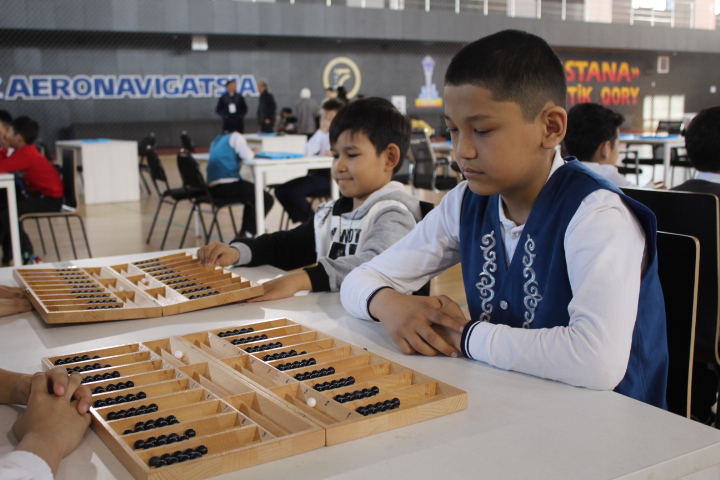ASTANA – The old tradition of board games revives with rising popularity among youth to play togyzkumalak (nine pellets) ahead of the fifth World Nomad Games in the Kazakh capital on Sept. 8 – 14.

Togyzkumalak revives in popularity among youth. Photo credit: Aida Dosbergenova/The Astana Times.
The traditional Kazakh board game togyzkumalak is also known as the “chess of the steppes” or the “algebra of the shepherds.” According to Kazakh legends, the game was invented by shepherds. Its name, which literally translates from Kazakh as “nine dung balls,” reflects the game’s origins, when shepherds would dig small pits in the ground and use dried dung balls to play. Now, togyzkumalak is usually played with pellets made of stone, wood, or metal.
The first official rules of togyzkumalak were codified in 1949 by Kazakh writer Mukhtar Auezov and actor Kalibek Kuanyshbayev. These rules are the basis for tournaments to this day.
Similar games are played in Turkic-speaking nations, such as toguz korgool in Kyrgyzstan, mangala in Türkiye, and mere köçdü in Azerbaijan.
In 2020, togyzkumalak, along with other nations’ alternatives such as toguz korgool and mangala/göçürme, was inscribed in the United Nations Educational, Scientific and Cultural Organization’s (UNESCO) Intangible Cultural Heritage List through a joint submission of Kazakhstan, the Kyrgyz Republic, and Türkiye.
Rules explained
Astana city’s senior coach Nurzhan Konarbayev explained the rules to The Astana Times.

Each player has nine sections called ‘otau’, 18 otaus in total. The board also has two larger rows on each player’s side called ‘kazan,’ which means cauldron. Photo credit: The Astana Times
“Togyzkumalak is a Kazakh mathematical and logical game with a 4,000-year history. This game is played between two people. In togyzkumalak, each player has nine sections called ‘otau’, 18 otaus in total. The board also has two larger rows on each player’s side called ‘kazan,’ which means cauldron. The game is played with what we call kumalak [pellet]. The number of kumalaks is 81 on one side and the same number on the opposite side, a total of 162 kumalaks. The first one to collect 82 kumalaks in his cauldron wins the game,” said Konarbayev.
The player who draws the first move is called the beginner. He takes all but one of the pellets out of any hole in his or her row and moves them from left to right, dropping one into each subsequent hole so that the last pellet lands on the side of the rival.
“He takes every kumalak except for one. Then he places one in each otau in a counter-clockwise direction. If the number of kumalaks in the opponent’s otau is even, he eats them, meaning he collects all the kumalaks into his cauldron. If their number is odd, it will not be ‘eaten.’ For example, now the number is even, so everything falls into the beginner’s cauldron,” Konarbayev shows as two young players engage in the game.
When discussing the differences between togyzkumalak and chess, Konarbayev said that, unlike chess, togyzkumalak requires a lot of counting.
“Chess players say that togyzkumalak is difficult. We have a lot of calculations, and in chess, even if you don’t count, you can still play. Here, you have to count where each pellet should go. It is necessary to control all this, and count your and your opponent’s pellets,” said Konarbayev.
Benefits for children
According to Dariyash Ramberdiyeva, a togyzkumalak coach among youth, the game offers numerous benefits, particularly in enhancing children’s critical thinking and math skills. It provides an engaging way for children to develop these important cognitive abilities.

The game enhances children’s critical thinking and math skills. Photo credit: Aida Dosbergenova/The Astana Times.
“The best feature of togyzkumalak is that it increases children’s thinking ability and alertness while educating them about Kazakh national traditions. Playing this traditional game instills discipline in children. Therefore, I believe I have chosen the right profession. I am confident that I am making a valuable contribution to the upbringing of young children and fostering their understanding of our national heritage,” said Ramberdiyeva.
Togyzkumalak is becoming increasingly popular among children and young people, with many parents choosing it as a national sport for their kids.
“We have a Togyzkumalak club at our school, where children come voluntarily. We have many participants, and I believe it’s because of the support from the children’s families. Whenever parents hear about our togyzkumalak club, they encourage their children to join. This shows that they value our national heritage, and it’s heartening to see this support,” Ramberdiyeva added.


